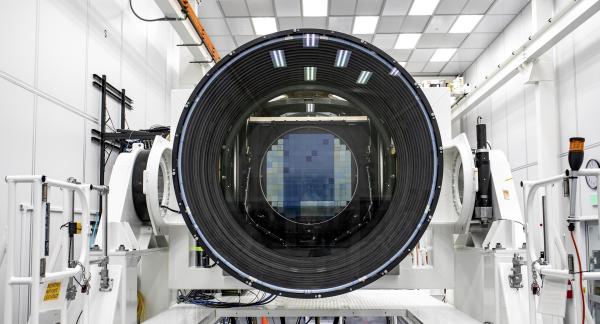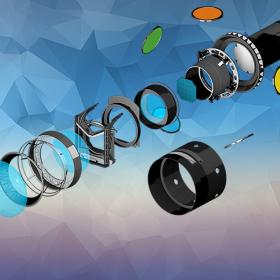NSF–DOE Rubin Observatory’s secondary mirror installed
The 3.5-meter glass mirror is the first permanent component of the Simonyi Survey Telescope's state-of-the-art, wide-field optical system to be installed and will soon contribute to a better understanding of our Universe.
LSST Camera
Vera C. Rubin Observatory will search wide and deep into the cosmos for signs of dark matter and dark energy and yield new insights into our own galaxy and solar system. SLAC built Rubin's LSST Camera (above), the largest camera ever built for astrophysics. SLAC will also host Rubin's U.S. Data Facility and co-lead the observatory's operations along with NSF's NOIRLab. (Image Credit: Jacqueline Ramseyer Orrell/SLAC National Accelerator Laboratory)

The summit team at the NSF–DOE Vera C. Rubin Observatory in Chile has installed the 3.5-meter glass secondary mirror assembly on the Simonyi Survey Telescope. This achievement marks the successful integration of the first permanent component of the telescope’s optical system, which also includes an 8.4-meter primary/tertiary mirror and the LSST Camera – the largest digital camera in the world. Rubin Observatory, funded by the U.S. National Science Foundation and the U.S. Department of Energy’s Office of Science, is poised to kick off a new era in astronomy and astrophysics with the 10-year Legacy Survey of Space and Time (LSST), beginning in 2025.
The installation of the complete mirror assembly was the culmination of many years of hard work and planning by teams in the U.S. and in Chile. After fabrication and polishing, the glass blank and the mirror cell assembly components were shipped to Chile in 2018 and stored inside the observatory while work continued on the telescope mount. The secondary mirror was coated with protected silver at Rubin Observatory in 2019 and integrated with the mirror cell in early July 2024 before being installed on the telescope last week.
“Working with the mirror again after five years is extremely exciting because it really feels like we’re in the home stretch,” said Sandrine Thomas, Deputy Director for Rubin Observatory Construction, “Now we have glass on the telescope, which brings us a thrilling step closer to revolutionary science with Rubin.”
At just under four meters in diameter and 10 centimeters thick, Rubin’s secondary mirror is one of the largest convex mirrors ever made. Following delivery in 2009, the mirror blank was stored for five years at Harvard University before being polished and finished.
To install the mirror assembly onto the telescope mount, the Rubin summit team used a specialized cart to rotate the mirror assembly to a vertical position. They then lifted the assembly off of the cart and onto the telescope mount while maintaining active system control to prevent adding stress to the glass. After bolting the secondary mirror assembly in place, the summit team connected the mirror cell to the electronics cabinet on the telescope mount and reactivated the mirror’s software control system.
In the coming weeks the Rubin team will re-install the Commissioning Camera, a much smaller version of the LSST Camera, that will be used to conduct a variety of test campaigns on the mirror and its associated systems to ensure optimal performance. The team will also now focus on preparing the primary mirror assembly for telescope integration in August, and the LSST Camera for installation on the telescope later this year.
Rubin Observatory is a joint initiative of the National Science Foundation (NSF) and the Department of Energy (DOE). Rubin is operated jointly by NSF’s NOIRLab and SLAC.
This article is based on a story from Rubin Observatory.
For questions or comments, contact the SLAC Office of Communications at communications@slac.stanford.edu.
About SLAC
SLAC National Accelerator Laboratory explores how the universe works at the biggest, smallest and fastest scales and invents powerful tools used by researchers around the globe. As world leaders in ultrafast science and bold explorers of the physics of the universe, we forge new ground in understanding our origins and building a healthier and more sustainable future. Our discovery and innovation help develop new materials and chemical processes and open unprecedented views of the cosmos and life’s most delicate machinery. Building on more than 60 years of visionary research, we help shape the future by advancing areas such as quantum technology, scientific computing and the development of next-generation accelerators.
SLAC is operated by Stanford University for the U.S. Department of Energy’s Office of Science. The Office of Science is the single largest supporter of basic research in the physical sciences in the United States and is working to address some of the most pressing challenges of our time.







